The Formation of the Mind
One of the simplest but most powerful statements Maria Montessori wrote is about how the child builds himself: “Impressions do not merely enter a child’s mind; they form it.” She explains that there is a sort of mental chemistry as the child builds himself through experiences.
This statement calls to mind how we may feel on vacation in a new and interesting city: “So much to see and so little time to see it!”
 Lots to explore in a child’s room at home
Lots to explore in a child’s room at home
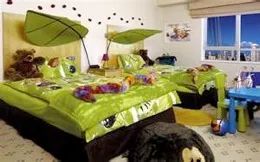
 Many interesting areas to explore in a well-equipped Montessori classroom
Many interesting areas to explore in a well-equipped Montessori classroom
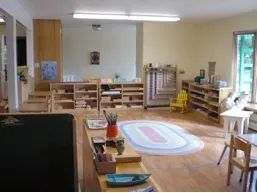
 Lots of fascinating, creative choices on just one set of shelves!
Lots of fascinating, creative choices on just one set of shelves!
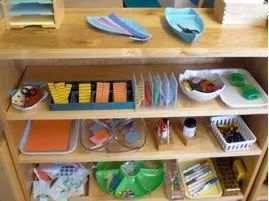
There is so much for the young child to see and do to form himself and, in the scope of life, so little time to do it! What does this mean on a practical level for us as parents and teachers of young children? How can we use this little tidbit of wisdom to help us most effectively assist our children? One way to look at it is to begin to discriminate what we want our children to build with.
Getting to know your environment
The way we raise and educate our children is a reflection of how we want to live our lives. Child-rearing and education are reflections of our values. We live in a very complex society and we have to make choices about what we want our children to see, hear and become.

To me, the first choice is life. I want to expose children to the amazing natural world, to living things, to the positive and beautiful elements of life.
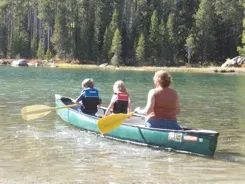
Some people say that children have to live in the real world and it is not always so positive or beautiful. True enough, yet the child has one period in his or her life to build the self – it is the period of the absorbent mind from conception to age six.
We can choose to be active with our children, take them to beautiful places, and watch films that are uplifting rather than frightening or confusing. It does not cost anything to play catch in your yard, walk through a peaceful park, visit the flowers in a lovely nursery, or go to your local museums on the free day of the month.
It does not cost anything to go to the public library and browse the children’s section to find beautiful picture books, illustrated poetry and classics for young children. And your child can often attend free story-time at libraries.
 Seeing a real parrot after hearing a story about a parrot
Seeing a real parrot after hearing a story about a parrot
– it doesn’t get much better than this!
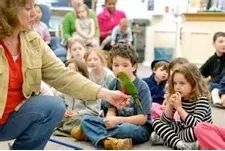
The distortions of cartoons have some downsides
Montessori expert Dr. Elisabeth Caspari often spoke of developing the aesthetic sense in children from an early age. When we watched some American cartoons together early one Saturday morning to see what they were like, her first comment was why would parents allow their children’s sense of beauty become warped by watching distorted images often doing hurtful things? If you set your standards for beauty rather than goofy cartoons, your child will build himself out of harmonious patterns in his consciousness. But there is another reason to avoid cartoons.
Sixty 4-year-olds randomly assigned to watch a fast-paced television cartoon or an educational cartoon or draw for 9 minutes were then given four tasks that use their executive function (self-regulation, working memory). Parents completed surveys regarding television viewing and child’s attention. The study found that just 9 minutes of viewing a fast-paced television cartoon had immediate negative effects on 4-year-olds’ executive function, causing researchers to advise parents that fast-paced television shows can at least temporarily impair young children’s executive functions. Lillard, A.S. & Peterson, J., “The Immediate Impact of Different Types of Television on Young Children’s Executive Function,” Pediatrics 128: e1-e6 (Oct. 2011), downloaded from pediatrics.aappublications.org on September 18, 2011.
Sharing our interests
Little ones are building themselves as they are learning about life. Why not let them learn of a more refined beauty rather than distortions? Looking at amazing images of whatever interests you that you want to share with your child—whether it is seashells, flowers or constellations— creates not only healthy mental development but bonding with your child.
A simple Montessori principle of learning is to give the child something to do with her hands. Impressions are far more lasting when the child is working with an object for fifteen minutes rather than just casting it a passing glance.
Matching cards
A fun and interesting activity for young children is what we call matching objects or matching cards. You get two matching objects or images of items that are in one particular category. Keeping them in one category at a time helps build the mental structure of learning to categorize. In this case, it is seashells. You can download images from the Internet, buy matching postcards, work with seed packets or use personal photographs.
Lay out one set of objects or pictures in a column along the edge of a carpet or piece of felt so the items are flush left. Place the matching objects or cards at random and show the child how to match them as shown below.

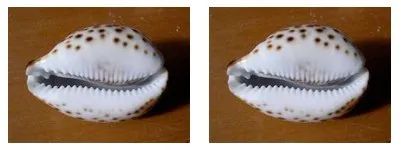

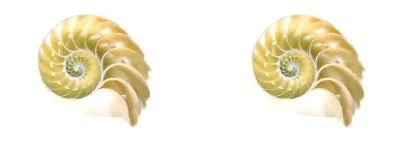
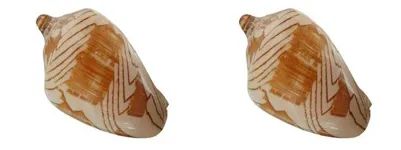
You will notice that the pictures are clear and uncluttered. They show just one item in great detail. They leave impressions worthy of the child’s attention. Six to ten pairs may be enough to start with for a 2½-3-year-old. If you have more pairs, you can rotate new ones after a few days. You want to show the child how to lay the materials out in an orderly fashion.
From visual matching you can move on to teach vocabulary, just naming the items orally or giving your child reading labels. You could take a world map and explore where in the world these shells are found, how they have been used, and what the little animals inside look like as well as their physiology.
You can create sets of objects or cards for cars, trucks, minerals, office supplies, grains, tropical fruits, national costumes, flowers or virtually anything that interests your child. One interesting and fun idea is to make matching cards of all the trees and shrubs in your yard and learn their names. Your child will glean impressions of beauty and order and, in many cases, spark what well may be lifelong interests. The focus on what the child finds interesting leads to concentration and organized facts that can open up entire bodies of knowledge.
Personalize your lessons
I love art, and my family and I always visit the local art museums wherever we go. After a year abroad back in the 1970s, I remember coming home with about $100 worth of art postcards from wonderful museums. I gave lessons on different kinds of paintings – landscapes, cityscapes, portraits and still-lives as well as different styles, countries of origin and artists for many years to come.
Little ones matched the pictures and learned the names of great works of art as well as the names of the artists. They gathered multiple impressions of great beauty and creativity. Older ones researched the artists and schools of art. I learned a great deal, I loved sharing my love of art, and the children in my classrooms loved the beautiful pictures that represented people and places from around the world.






















